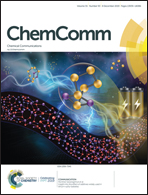Why does sulfite reductase employ siroheme?†
Abstract
Sulfite reductase (SiR) contains in the active site a unique assembly of siroheme and a [4Fe4S] cluster, linked by a cysteine residue. Siroheme is a doubly reduced variant of heme that is not used for a catalytic function in any other enzyme. We have used non-equilibrium Green's function methods coupled with density functional theory computations to explain why SiR employs siroheme rather than heme. The results show that direct, through vacuum, charge-transfer routes are inhibited when heme is replaced by siroheme. This ensures more efficient channelling of the electrons to the catalytic iron during the six-electron reduction of sulfite to sulfide, limiting potential side-reactions that could occur if the incoming electrons were delocalized onto the macrocyclic ring.



 Please wait while we load your content...
Please wait while we load your content...